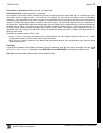
L NAPCO Security Systems
Freedom F-64 Installation Instructions
WI1501A 9/06
Page 35
Zone Number on Pulse Alarm See Data Formats: Two-Digit Format
Zone Response Time (750mS required for UL installations)
Loop response is the amount of time in milliseconds (mS) that a normally-closed circuit must remain open, or a normally-open circuit
must remain closed, to trigger an alarm. The slower the loop response, the more immune the system will be to intermittents
("swingers"). Loop response times for Zones 1 through 8 are programmed into the control panel; Zones 9-16 with "Zone Doubling"
enabled have loop responses the same as their respective 1-8 zones; those for Zones 9 through 64 loop responses are selected in the
respective Touchpad Configuration Mode or expansion zone module jumper. The panel Zone Response time can be adjusted to a
new global value. Address 2062 accepts three decimal digits which are multiplied by 10 milliseconds to get a new value that replaces
the default value of 750ms. If the location is set to 000 the system will default to 750ms internally. The maximum value is 255. If a
value above 255 is entered the system will display 000 to request a re-entry. Note: Only the panel zones’ integration times are pro-
grammable. EZM’s will continue to use either 50 or 750 ms as selected by jumpers on the EZM. In addition, zone responses are en-
abled only when armed.
Selectable loop-response times for Zones 1–8 are:
• 750mS (.75 sec.): The slowest loop-response time, recommended for use with magnetic contacts, window foil, etc. Unless
programmed otherwise, loop-response time will be 750mS for all zones.
• 50mS (.05 sec.): Used for momentary Panic Buttons and area-protection devices, such as photoelectric eyes, passive infrared
sensors, floor mats, etc.
Zone Status
In high security installations where Disable Auto Status has been programmed, enter the User code at the keypad and press
R
until "DISPLAY ZONE STATUS Y/N" is displayed. Press NEXT/YES and then NEXT/PRIOR to scroll through any faulted zones.
Zone Type See Central Station Receiver Data Formats: Modem Formats
Glossary


















